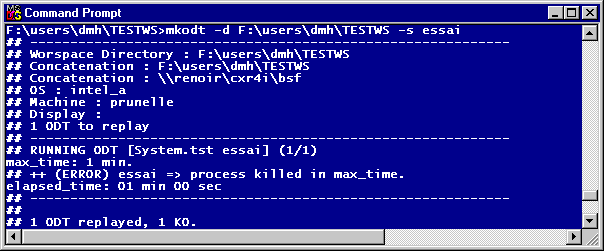
Elapsed time > max_time; the ODT is killed.

Elapsed time > max_time defined in the shell (SetOdtParam max_time=1) because -NOMaxTime had been used!!!
RADE |
Java Unit Test Manager |
Using mkodtCreating and running test objects |
| Technical Article | ||
AbstractThis article shows how to create and run java test objects, and how to use the commands and their options. |
SetOdtParam enables you to select the operating systems with which you want the test object to be replayed, and to set the maximum replay time
[Top]
To declare an ODT as a java ODT, the script must contain:
SetOdtParam TYPE=JAVABATCH
With this line the java environment will be set automatically, using the environment variable ADL_ODT_JRE. The CLASSPATH and the PATH wii be updated using this ADL_ODT_JRE variable.
Examples:
This line must appear in each script of java ODTs.
By default, a test object is replayed with any operating systems available on your site. If you don't want to replay a test object with a given operating system, use:
SetOdtParam Replay_xxx=NO
where xxx can have the following values: AIX, SunOS, HP-UX, Unix, Windows_NT,
aix_a, solaris_a, hpux_b,
and intel_a.
Examples:
SetOdtParam TYPE=JAVABATCH SetOdtParam Replay_intel_a=NO JavaReplay Appli exit $? |
SetOdtParam TYPE=JAVABATCH SetOdtParam Replay_Windows_NT=NO SetOdtParam Replay_solaris_a=NO SetOdtParam Replay_hpux_b=NO JavaReplay Appli exit $? |
By default, a test object is replayed with any JRE available on the OS. Here are the possible value of the JRE (The ADL_ODT_JRE environment variable ) for each OS:
Solaris and Windows sunjre_aAIX ibmjre_aHP_UX hpjre_aWindows (Microsoft JRE) msjre_a
On Windows, the default value of the JRE is sunjre_a.
If you don't want to replay a test object with a JRE, use:
SetOdtParam Replay_xxx=NO
where xxx can have the following values: sunjre_a, sgijre_a,
ibmjre_a, hpjre_a, msjre_a.
Examples:
SetOdtParam TYPE=JAVABATCH SetOdtParam Replay_msjre_a=NO JavaReplay Appli exit $? |
SetOdtParam TYPE=JAVABATCH SetOdtParam Replay_Unix=NO SetOdtParam Replay_sunjre_a=NO JavaReplay Appli exit $? |
The default replay time of a test object is five minutes. To modify this replay time, add to the test object script:
SetodtParam max_time=xx
where xx is the maximum replay time you want to set. It can't
exceed 60 minutes.
Example:
The following example shows a test object with a maximum replay time of ten minutes that will be replayed with Windows only.
SetOdtParam max_time=10 SetOdtParam Replay_Unix=NO JavaReplay MyAppli exit $? |
[Top]
This command can be used in shell script to find a directory or a file in the
workspace concatenation using the ADL_ODT_CONCATENATION variable.
It will be used to add .zip, .jar.... files in the CLASSPATH environment
variable.
Example: This test object that doesn't replay with Windows is going to
find in the workspace concatenation the file $OS/docs/java/GW0Start.jar
and will add this file in the CLASSPATH:
SetOdtParam TYPE=JAVABATCH SetOdtParam Replay_Windows_NT=NO
export CLASSPATH=$CLASSPATH${ADL_ODT_SEPARATOR}$(WhichDir $OS/docs/java/GW0Start.jar)
JavaReplay MyAppli
exit $?
|
[Top]
The ODTInit command is used to factorize steps of ODTs; Indeed, sometimes, ODTs could generate and use the same resources... But each ODT will create his own resources during a replay.
To use this command, the developer must create a shell script named ODTInit_logicname.sh in the ADL_ODT_IN directory. This shell will generate resources that will be used on this ODT.
The JavaReplay command is used to launch the given application or applet with the a given JRE .
Example:
Normally, to test a java Application, you have to launch, after having updated the PATH and the CLASSPATH variables:
java MyAppli
or
jview MyAppli
With mkodt java, you do not have to set PATH and CLASSPATH, except to add specific .jar in your CLASSSPATH; To launch your java application, you just have to type your ODT as a JAVABATCH ODT and to use the JavaReplay command:
SetOdtParam TYPE=JAVABATCH
export CLASSPATH=$CLASSPATH${ADL_ODT_SEPARATOR}$(WhichDir $OS/docs/java/GW0Start.jar)
JavaReplay MyAppli
exit $?
|
This ODT will be replayed on every JRE. The default JRE for each OS are:
| Solaris and Windows | sunjre_a |
| AIX | ibmjre_a |
| HP_UX | hpjre_a |
| Windows (Microsoft JRE) | msjre_a |
If you wish to replay your ODT on the Microsoft's JRE (on Windows), you must launch:
set ADL_ODT_JRE=msjre_a
mkodt -s monODT
This will set the ADL_ODT_JRE to msjre_a, and, with the SetOdtParam TYPE=JAVABATCH and the javaReplay command used in the script, the replay on this JRE will be done automatically without having to se more variables.
[Top]
These standard options are used to replay ODTs in a local workspace or in an official workspace:
| Command Line | ODTs Replayed |
|---|---|
| mkodt -W MONWS -F MONFW -a ( option -W available on UNIX only) | Replay all ODTs of $HOME/MONWS/MONFW |
| mkodt -d /u/lego/CXR4/BSF -a -S -o /u/users/toto/output | Replay all Switch ODTs of CXR4 and generate Output in /u/users/toto/output directory |
| mkodt -s DRW*Rec | Replay all ODTs DRW*Rec of the current workspace. |
[Top]
| Command Line | ODTs Replayed |
|---|---|
| mkodt -d \\renoir\CXR4\BSF -a -S -o E:\users\toto\output -p e:\steplib\CXR4\LocalWS |
$ADL_ODT_CONCATENATION= e:\steplib\CXR4\LocalWS Runtime Concatenation = e:\steplib\CXR4\LocalWS |
| mkodt -d \\renoir\CXR4\BSF -a -S -o E:\users\toto\output -r e:\steplib\CXR4\LocalWS |
$ADL_ODT_CONCATENATION=\\renoir\CXR4\BSF Runtime Concatenation = e:\steplib\CXR4\LocalWS |
| mkodt -d \\renoir\CXR4\BSF -a -S -o E:\users\toto\output -r e:\steplib\CXR4\LocalWS -p \\renoir\CXR4rel\BSF |
$ADL_ODT_CONCATENATION=\\renoir\CXR4rel\BSF Runtime Concatenation = e:\steplib\CXR4\LocalWS |
[Top]
This option suspend the supervision of max_time ODT:
Example:
For the following example:
SetOdtParam TYPE=JAVABATCH SetOdtParam max_time=1 JavaReplay Appli exit $? |

Elapsed time > max_time; the ODT is killed.

Elapsed time > max_time defined in the shell (SetOdtParam max_time=1) because -NOMaxTime had been used!!!
[Top]
[Top]
[Top]
To change the output directory, there are two possibilities:
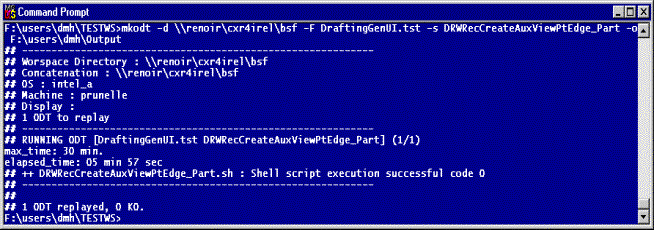
Created directories:
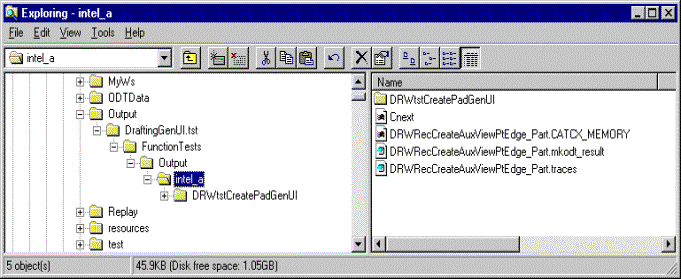
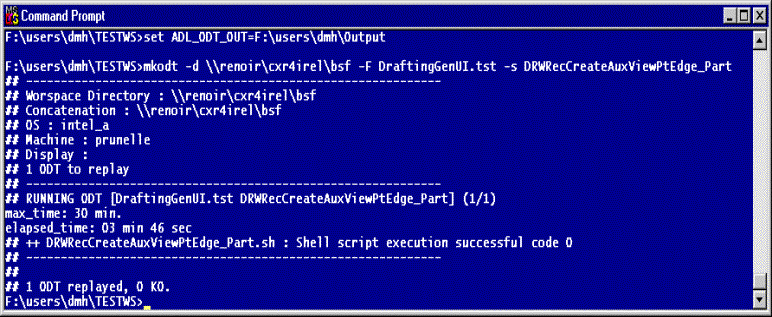
Created directories:
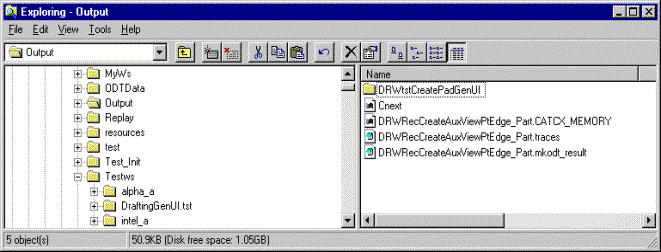
If ADL_ODT_OUT is not set or if users don't use the -o option, the output directory is: WSROOT/FW.tst/FunctionTests/Output/$OS. If the workspace is read-only, the output will be saved in ADL_ODT_TMP.
Example:
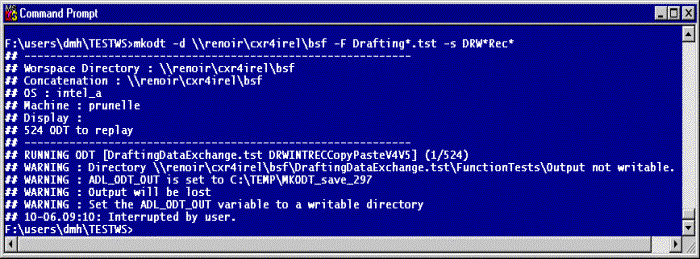
In this example, we replayed ODTs DRW*Rec* in frameworks Drafting*.tst in the CXR4rel level; mkodt found 524 ODTs; Furthermore, there is no option -o in the command line and the ADL_ODT_OUT is not set, so the mkodt ouput's will be sqved in ADL_ODT_TMP\MKODT_save_297. The command had been interrupted by user (^C).
[Top]
[Top]
These options are used to modify the output of the mkodt command (-q, -X) or to give a list of ODT to replay (-L, -l):
| Command Line | ODTs Replayed |
|---|---|
| mkodt -d E:\users\toto\MONWS -a -S -q -o E:\users\toto\output (intel_a) | Replay all Switch ODTs of MONWS in quiet mode. |
| mkodt -d /u/users/toto\MONWS -s CCPCutRec -X -o E:\users\toto\output | The ODT CCPCutRec will be replayed and its output will be redirected on output screen in real time. |
|
mkodt -d /u/users/toto\MONWS -L /u/users/toto\MONWS/ FileListODT -X -o E:\users\toto\output or mkodt -d /u/users/toto\MONWS -L FileListODT -X -o E:\users\toto\output |
The file FileListODT contain the ODT list to replay; This file has the following format: FW1 TypeODT ODTName1 FW2 TypeODT ODTName2 …… |
|
mkodt -d /u/users/toto\MONWS -l FileListFWODT -X -o E:\users\toto\output |
The file FileListFWODT contain the ODT list to replay; This file has the following format: ODTName1 ODTName2 ... |
[Top]
| Version: 1 [March 2001] | Document created |
| [Top] | |
Copyright © 2000, Dassault Systèmes. All rights reserved.